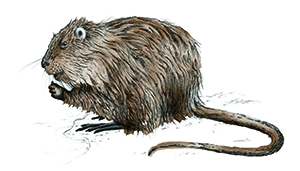Home → Fish & Wildlife → Wildlife → Species Information → Mammals → Muskrat
Muskrat
Ondatra zibethicus
On this page:

Habitat
In wetlands with dense emergent vegetation, with a preference for slow or still water, muskrats build small lodges out of aquatic plants, under root balls, in streams and pond embankments, and under docks.
Diet
This omnivore eats cattails, reeds, rushes, and pond-weeds; but also some mussels, insects, and crayfish.
Distinctive Characteristics
A small aquatic rodent, one to two feet long, with glossy, brown waterproof fur and a skinny rat-like tail that makes a V shape when it swims.
Nocturnal/Diurnal
Active all day throughout the year, the muskrat maintains water access routes through ice in winter, and can stay under water for up to 15 minutes.
Reproduction & Family Structure
Four to eight young are born sometime between March and October.
Living with Wildlife
How to Prevent or Resolve Conflicts with Muskrats
Most damage from muskrats are from burrowing and digging that can weaken dikes and dams. Learn how to make your area less attractive to muskrats.